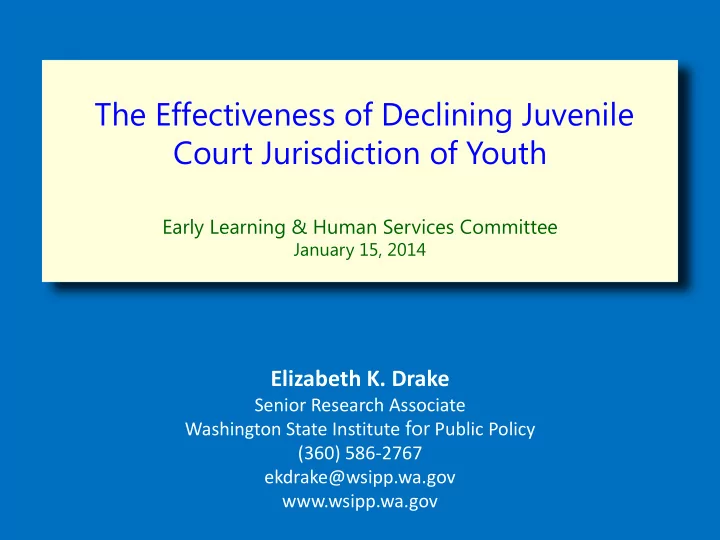

The Effectiveness of Declining Juvenile Court Jurisdiction of Youth Early Learning & Human Services Committee January 15, 2014 Elizabeth K. Drake Senior Research Associate Washington State Institute for Public Policy (360) 586-2767 ekdrake@wsipp.wa.gov www.wsipp.wa.gov
Washington State Institute for Public Policy Created by the 1983 Legislature Mission : Conduct non – partisan research on projects assigned by the Legislature or WSIPP’s Board of Directors WSIPP Board of Directors Co-Chairs: Rep. Maureen Walsh Sen. Jeanne Kohl-Welles Rep. Cary Condotta Sen. Joe Fain Rep. Ruth Kagi Sen. Karen Fraser Rep. Larry Springer Sen. Mark Schoesler Jill Reinmuth, House Staff Richard Rodger, Senate Staff Sandra Archibald, UW David Schumacher, OFM Director Rodolfo Arévalo, EWU Gubernatorial Appointee Vacancy Les Purce, Evergreen Robert Rosenman, WSU WSIPP’s Board of Directors was asked to do this project by the Washington State Partnership Council on Juvenile Justice. The study was authorized by the Board in 2012. 2 of 8
Decline of Juvenile Court Jurisdiction Washington State Law Juvenile courts have jurisdiction over youth under the age of • 18 who allegedly commit a crime Legally, youth can be “declined” jurisdiction in the juvenile • court through two ways: 1) Discretionary decline – prosecutors can petition to transfer a youth to adult court at the discretion of the juvenile court 2) Automatic decline – youth statutorily transferred to adult court based on certain criteria (age, current offense, and criminal history) Enacted in 1994 and expanded in 1997 3 of 8
WSIPP’s Evaluation of Automatic Decline Law Effect on Recidivism We compared 36-month recidivism rates of youth subject to the law to youth prior to the 1994 law who would have met the exact age and offense criteria Youth prior to law Automatically declined youth (comparison group) (treatment group) 440 youth 770 youth 1994 law 1992 2009 This circumstance did not exist for youth who were discretionarily declined; thus, we were only able to test the effects of the automatic decline law 4 of 8
Findings: 36-Month Reconviction Rates Automatically Declined Youth Compared to Pre-1994 Group 80% Automatically declined group Pre-1994 group 70% 72% 60% 65% Recidivism Rate 50% 57% 40% 43% 30% 38% 20% 23% 10% 0% Total Felony Violent felony Recidivism Measure 5 of 8
Systematic Review of the National Research Literature WSIPP Findings are Consistent WSIPP , 2013 Fagan, 1995 (NY) Studies Fagan et al., 2007 (NY) Weighted average effect -0.200 0.000 0.200 0.400 Less recidivism ……..… Effect ……..…. More recidivism 6 of 8
What are the Benefits and Costs of the Law? Our Empirical Investigation is Only a Piece of the Puzzle We empirically examined the impact of decline law on: Recidivism (“specific deterrence”) Unfortunately, we could not empirically examine the impact of two other factors: General deterrence Incapacitation Thus, because we did not want to speculate about these two factors, we could not conduct a complete benefit-cost analysis. 7 of 8
The Question Why Do Automatically Declined Youth Higher Recidivism? Theory: Increased time in confinement? Testable with the data Youth in the decline group spent an additional 20 months in confinement Finding: We found no relationship between the increased length of stay and recidivism Theory: Criminogenic effect (producing criminality) of processing youth in the adult CJS? Not testable with the data = finding unknown Theory: Location of confinement (JRA vs. DOC)? Not testable with the data = finding unknown 8 of 8
Thank You
Recommend
More recommend